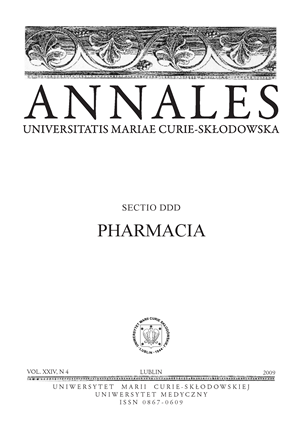FGF-21 – can it be a promising agent in the treatmentof type 2 diabetes?
Abstract
Diabetes type 2 has become an increasing global health problem in recent years and cardiovascular complications are the leading cause of death in this group of patients. Insulin resistance, which mainly concerns adipose tissue, skeletal muscles and the liver, is a dominant phenomenon in the pathogenesis of type 2 diabetes and other metabolic disorders. Overwhelming evidence that diabetes increases mortality and deteriorates the quality of life supports the importance of searching new markers of insulin resistance which may be a potential target for the therapy. Fibroblast growth factor 21 (FGF-21) is newly discovered, a unique member of the FGF family that functions as an endocrine hormone. It has been reported as a potent metabolic regulator, which in animal models has been shown to improve glucose metabolism and insulin sensitivity. FGF-21 acts as an activator of glucose uptake on adipocytes, protects animals from diet-induced obesity when overexpressed in transgenic mice, it lowers blood glucose and improves lipids profile when therapeutically administered to diabetic rodents. The most recent scientific research suggests that FGF-21 improving insulin sensitivity, may be a novel and attractive drug candidate for the treatment of cardiovascular diseases, especially obesity and type 2 diabetes. However, further investigations are required to determine whether the unique metabolic effects of FGF-21 shown in rodents and primates are also present in humans.
References
1. Badman M. K. et al.: Fibroblast growth factor 21-deficient mice demonstrate impaired adaptation to ketosis. Endocrinology, 150 (11), 4931, 2009.
2. Chen W. W. et al.: Circulating FGF-21 levels in normal subjects and in newly diagnosed patients with Type 2 diabetes mellitus. Exp. Clin. Endocrinol. Diabetes, 116 (1), 65, 2008.
3. Coskun T. et al.: Fibroblast growth factor 21 corrects obesity in mice. Endocrinology, 149 (12), 6018, 2008.
4. Goetz R. et al.: Molecular insights into the klotho-dependent, endocrine mode of action of fibroblast growth factor 19 subfamily members. Mol Cell Biol., 27 (9), 3417, 2007.
5. Huang X. et al.: Forced expression of hepatocyte-specific fibroblast growth factor 21 delays initiation of chemically induced hepatocarcinogenesis. Mol. Carcinog., 45 (12), 934, 2006.
6. Inagaki T. et al.: Endocrine regulation of the fasting response by PPARalpha-mediated induction of fibroblast growth factor 21.Cell Metab., 5 (6), 415, 2007.
7. Ito S. et al.: Molecular cloning and expression analyses of mouse betaklotho, which encodes a novel Klotho family protein. Mech Dev., 98 (1-2), 115, 2000.
8. Kharitonenkov A. et al.: FGF-21 as a novel metabolic regulator. J. Clin. Invest., 115 (6), 1627, 2005.
9. Kharitonenkov A. et al.: FGF21: a novel prospect for the treatment of metabolic diseases. Curr. Opin. Investig. Drugs, 10 (4), 359, 2009.
10. Kharitonenkov A. et al.: The metabolic state of diabetic monkeys is regulated by fibroblast growth factor-21. Endocrinology, 148 (2), 774, 2007.
11. Kuroo M. et al.: Mutation of the mouse klotho gene leads to a syndrome resembling ageing. Nature, 390 (6655), 45, 1997.
12. Poirier P. et al.: Obesity and cardiovascular disease: pathophysiology, evaluation, and effect of weight loss: an update of the 1997 American Heart Association scientific statement on obesity and heart disease from the obesity committee of the council on nutrition, physical activity, and metabolism. Circulation, 113, 898, 2006.
13. Stein S. et al.: Serum levels of the adipokine FGF21 depend on renal function.Diabetes Care, 32 (1), 126, 2009.
14. Wang H. et al.: Identification of a domain within peroxisome proliferator-activated receptor gamma regulating expression of a group of genes containing fibroblast growth factor 21 that are selectively repressed by SIRT1 in adipocytes. Mol. Cell Biol., 28 (1), 188, 2008.
15. Wente W. et al.: Fibroblast growth factor-21 improves pancreatic beta-cell function and survival by activation of extracellular signal-regulated kinase 1/2 and Akt signaling pathways. Diabetes, 55, 2470, 2006.
16. Xu J. et al.: Fibroblast growth factor 21 reverses hepatic steatosis, increases energy expenditure, and improves insulin sensitivity in diet-induced obese mice. Diabetes, 58 (1), 250, 2009.
17. Zhang X. et al.: Receptor specificity of the fibroblast growth factor family. The complete mammalian FGF family. J. Biol. Chem., 281 (23), 15694, 2006.
18. Zhang X. et al.: Serum FGF21 levels are increased in obesity and are independently associated with the metabolic syndrome in humans. Diabetes, 57 (5), 1246, 2008.
Downloads
Published
Issue
Section
License
Copyright (c) 2009 Authors

This work is licensed under a Creative Commons Attribution-NonCommercial-NoDerivatives 3.0 Unported License.


